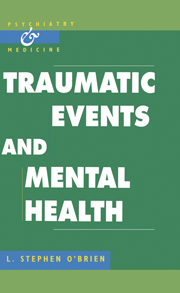Book contents
- Frontmatter
- Contents
- Foreword
- 1 Introduction and historical perspective
- 2 Normal reactions to trauma
- 3 Epidemiology of post-traumatic stress disorder and post-traumatic illness
- 4 Aetiology and predisposing factors
- 5 What constitutes a stressor?
- 6 Post-traumatic illness other than post-traumatic stress disorder
- 7 Diagnosis and assessment
- 8 Management and outcome of post-traumatic illness
- 9 Medicolegal aspects of post-traumatic illness
- 10 Prevention of post-traumatic illness
- 11 The way ahead – whither now?
- Index
11 - The way ahead – whither now?
Published online by Cambridge University Press: 05 May 2010
- Frontmatter
- Contents
- Foreword
- 1 Introduction and historical perspective
- 2 Normal reactions to trauma
- 3 Epidemiology of post-traumatic stress disorder and post-traumatic illness
- 4 Aetiology and predisposing factors
- 5 What constitutes a stressor?
- 6 Post-traumatic illness other than post-traumatic stress disorder
- 7 Diagnosis and assessment
- 8 Management and outcome of post-traumatic illness
- 9 Medicolegal aspects of post-traumatic illness
- 10 Prevention of post-traumatic illness
- 11 The way ahead – whither now?
- Index
Summary
Thus far this book has been intended to present the case for the importance and relevance of PTI in general and PTSD in particular. The aim of this chapter is to present some personal ideas and questions, and to try to consider the future direction of work on the psychological effects of trauma and the postulated physical effects in the brain of psychological trauma. It is unashamedly a personal view and is intentionally written without references, although hopefully the sources of most of the questions and problems have been detailed in the text thus far.
Trauma and mental illness are a subject which has inevitably preoccupied me over the years because of my employment. As a trainee psychiatrist in the army it seemed inevitable that I would be confronted with the history of battle shock and the future of combat stress in the anticipated battlefields of North West Europe. In the event the first case of PTI which I met was from one of the sad series of airline crashes which have come to be known by the name of the relevant city, or airfield, or flight number. What it taught me was the power of trauma and the intransigence of avoidance symptoms. A series of individual cases from Northern Ireland and from the Falklands taught me about PTI and then about PTSD. What they taught me was not so much the uniformity and the commonality of post-traumatic illnesses, but the variety of post-traumatic responses.
- Type
- Chapter
- Information
- Traumatic Events and Mental Health , pp. 282 - 294Publisher: Cambridge University PressPrint publication year: 1998

